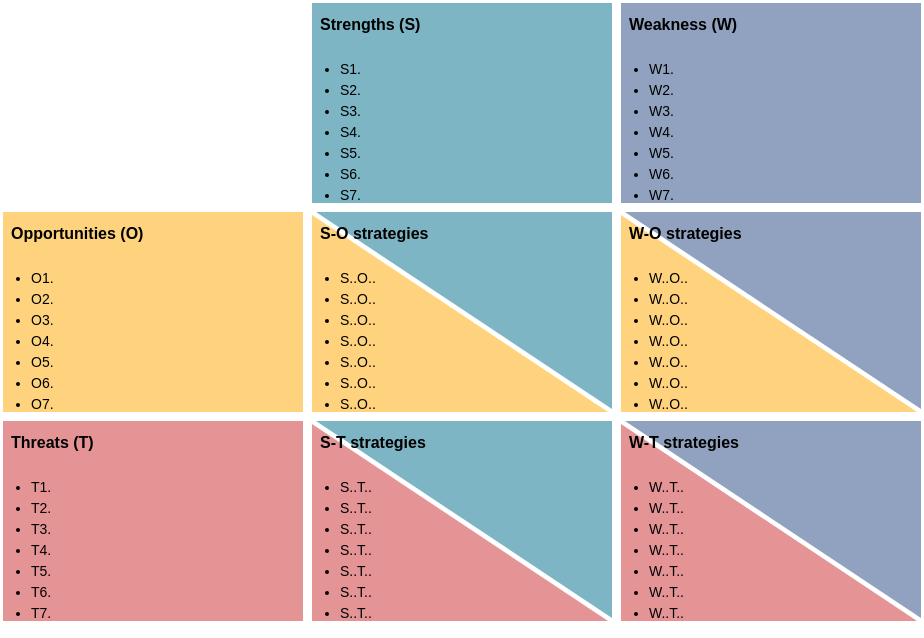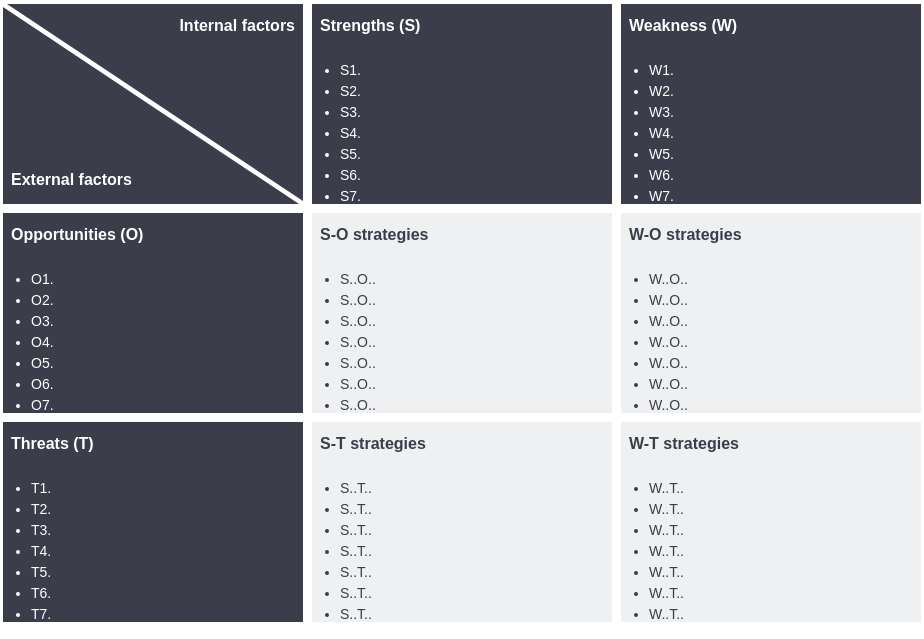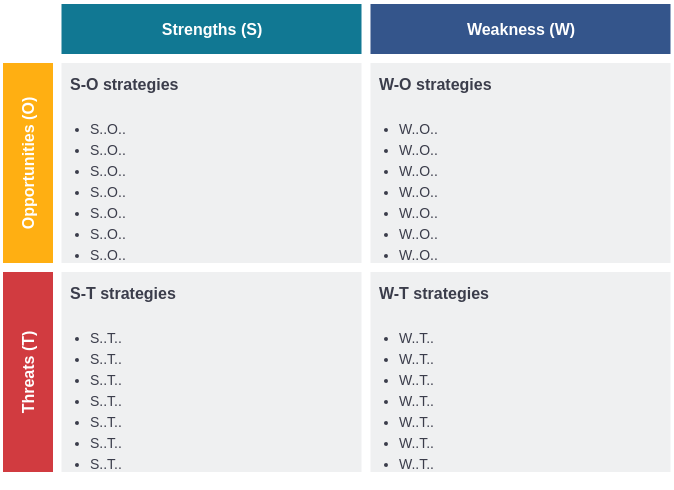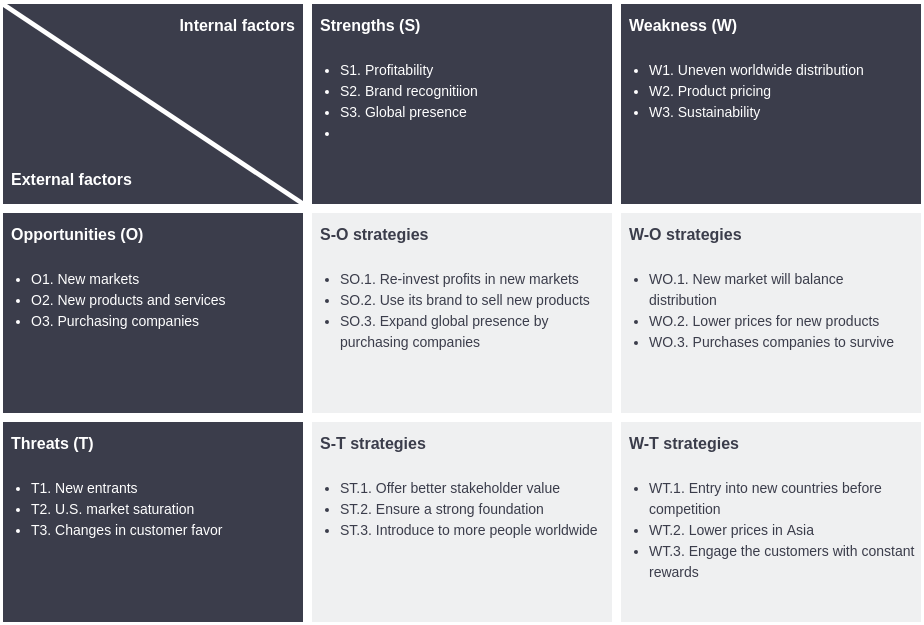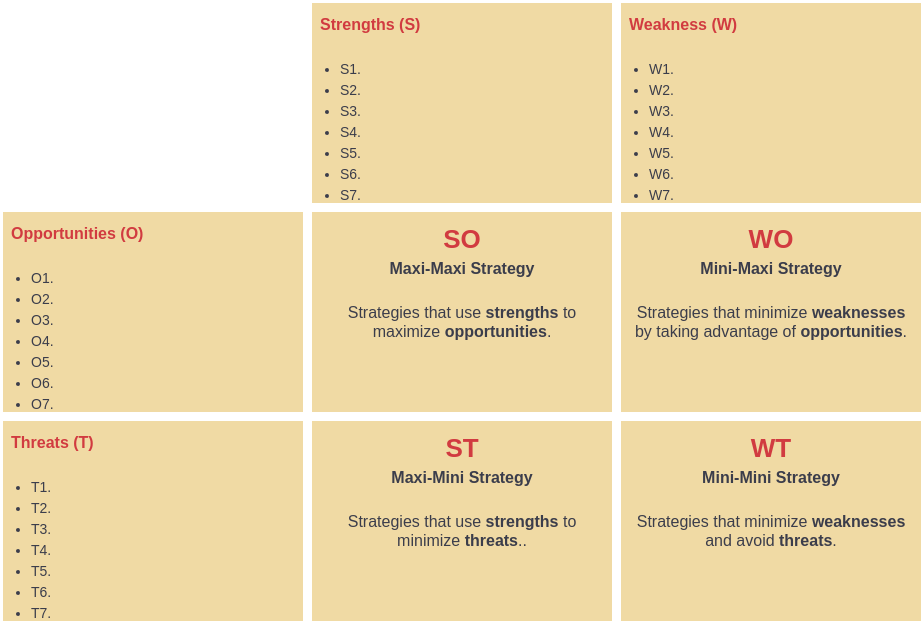Introduction to TOWS Analysis
TOWS analysis is an extension of the SWOT analysis, focusing on the relationships between internal and external factors. While SWOT identifies strengths, weaknesses, opportunities, and threats, TOWS takes it a step further by developing actionable strategies based on these factors.
Understanding TOWS Components
- Strengths (S): Internal attributes that support successful outcomes.
- Weaknesses (W): Internal factors that can hinder performance.
- Opportunities (O): External conditions that could be advantageous.
- Threats (T): External challenges that could harm the organization.
TOWS Matrix
The TOWS matrix is structured in a way that allows for strategic formulation by combining internal and external factors:
- SO (Strengths-Opportunities): Use strengths to seize opportunities.
- WO (Weaknesses-Opportunities): Overcome weaknesses by leveraging opportunities.
- ST (Strengths-Threats): Use strengths to mitigate threats.
- WT (Weaknesses-Threats): Minimize weaknesses to avoid threats.
TOWS Analysis of McDonald’s
Step 1: Identify Factors
Strengths:
- Global Brand Recognition: McDonald’s is one of the most recognizable brands worldwide.
- Extensive Menu Variety: Offers a diverse menu catering to different tastes and dietary preferences.
- Strong Supply Chain: Efficient logistics and supply chain management ensure consistent product availability.
- Innovative Marketing Strategies: Engages customers through targeted ads and promotions.
Weaknesses:
- Perception of Unhealthy Food: Fast food is often associated with unhealthy eating habits.
- High Employee Turnover: The fast-food industry faces challenges with staff retention and training.
- Dependence on Franchise Model: Reliance on franchisees can lead to inconsistent service quality.
Opportunities:
- Expansion into Emerging Markets: Growing middle-class populations in countries like India and China.
- Health-Conscious Menu Options: Increasing demand for healthier food alternatives.
- Technological Advancements: Opportunities in digital ordering and delivery services.
- Sustainability Trends: Growing consumer interest in sustainable practices.
Threats:
- Intense Competition: Other fast-food chains and health-focused restaurants are increasing market share.
- Economic Recession: Economic downturns can reduce consumer spending on dining out.
- Changing Consumer Preferences: A shift towards healthier eating habits can impact sales.
- Regulatory Challenges: Increased regulations on food quality and labor laws.
Step 2: Formulate Strategies
SO Strategies (Strengths-Opportunities)
- Leverage Brand Recognition for Market Expansion: Utilize McDonald’s strong global presence to enter emerging markets with tailored marketing campaigns.
- Develop Health-Conscious Menu Items: Use existing supply chain strengths to introduce healthier options, capitalizing on the trend towards wellness.
WO Strategies (Weaknesses-Opportunities)
- Invest in Employee Training Programs: Address high turnover by enhancing training and development initiatives, thus improving service quality and customer satisfaction.
- Innovate Menu Offerings: Collaborate with nutritionists to create healthier menu options, appealing to the growing consumer demand for healthier choices.
ST Strategies (Strengths-Threats)
- Strengthen Loyalty Programs: Utilize innovative marketing strategies to reinforce customer loyalty amidst increasing competition.
- Enhance Quality Control Measures: Leverage strong supply chain capabilities to maintain product quality and consistency, minimizing the impact of competitive threats.
WT Strategies (Weaknesses-Threats)
- Implement Operational Efficiency Programs: Reduce dependence on franchisees by enhancing corporate training and operational standards to ensure consistent service quality.
- Adapt to Regulatory Changes: Stay proactive in addressing regulatory challenges by adopting best practices in food safety and labor relations.
Here’s a summarized TOWS Matrix for McDonald’s:
| Opportunities (O) | Threats (T) | |
|---|---|---|
| Strengths (S) | SO Strategies | ST Strategies |
| 1. Leverage brand recognition for market expansion. | 1. Strengthen loyalty programs to enhance customer retention. | |
| 2. Develop health-conscious menu items to meet consumer demand. | 2. Enhance quality control measures to maintain product consistency and combat competition. | |
| Weaknesses (W) | WO Strategies | WT Strategies |
| 1. Invest in employee training programs to reduce turnover and improve service quality. | 1. Implement operational efficiency programs to ensure consistent service across franchises. | |
| 2. Innovate menu offerings with healthier options, leveraging nutritionist collaborations. | 2. Adapt to regulatory changes proactively by adopting best practices in food safety. |
This matrix provides a clear overview of how McDonald’s can leverage its strengths and opportunities while addressing weaknesses and threats.
Conclusion
TOWS analysis offers a strategic framework for McDonald’s to navigate its business environment effectively. By leveraging its strengths, addressing weaknesses, seizing opportunities, and mitigating threats, McDonald’s can enhance its competitive position in the fast-food industry. This structured approach not only facilitates strategic planning but also provides a roadmap for sustainable growth and adaptation to changing market dynamics.
Visualizing your TOWS analysis with Visual Paradigm Online not only enhances clarity and engagement but also leaves a lasting impression on your audience. By following the steps outlined above, you can create a stunning presentation that effectively communicates your strategic insights. Start leveraging the power of visualization today to elevate your TOWS analysis presentations!
Edit TOWS Analysis Templates
